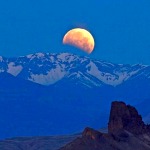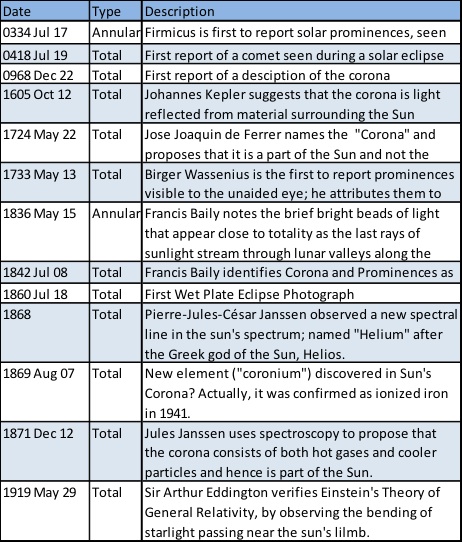
Today's Total Solar Eclipse - August 21, 2017
On Monday, August 21, 2017, all of North America will be treated to an eclipse of the sun. Anyone within the path of totality can see one of nature’s most awe inspiring sights - a total solar eclipse. This path, where the moon will completely cover the sun and the sun's tenuous atmosphere - the corona - can be seen, will stretch from Salem, Oregon to Charleston, South Carolina. Observers outside this path will still see a partial solar eclipse where the moon covers part of the sun's disk. NASA has created a website to provide a guide to this amazing event. Click Here eclipse2017.nasa.gov to find activities, events, broadcasts, and resources from NASA and our partners across the nation.
A Brief History of Eclipses
The earliest writings we have showing that people paid attention to eclipses in any official way are around 5,000 years old.
In 1999, Irish Archeoastronomer Paul Griffin investigated the Loughcrew Cairn L Megalithic Monument in Ireland, and discovered that a set of spiral-shaped petroglyphs that might correspond to a solar eclipse which occurred on November 30, 3340 BCE. The symbols display a consistent coding of the sun, moon and horizon, and of the 92 tracks of total solar eclipses, only the one for 3340 BCE visible at this site displayed the same geometric relationships.
Ancient Chinese Records —in particular, the Shu Ching—of the solar eclipse that occurred (most likely) on 22 Sun Earth Day 2009 Banner showing path of total solar eclipse across China.
October 2134 B.C.E. include a passage that translates in English to “the Sun and Moon did not meet harmoniously.”
In Ancient China, solar and lunar eclipses were regarded as heavenly signs that foretold the future of the Emperor. The ancient Chinese believed that solar eclipses occur when a celestial dragon devours the sun. They also believed that this dragon attacks the Moon during lunar eclipses. In the Chinese language, the term for eclipse was "shi" which also means "to eat". One ancient Chinese solar eclipse record describes a solar eclipse as "the sun has been eaten". It was a tradition in ancient China to bang drums and pots and make loud noise during eclipses to frighten the dragon away. The Chinese Imperial Emperor Chung K’ang (B.C.E. 2159 – 2146) learned of an eclipse when he heard much noise in the streets as his subjects tried to drive away the dragon that was eating the sun. They were successful, but the Emperor’s two court astronomers, Hsi and Ho, were reportedly beheaded for failing to predict the event.
Babylonian Clay Tablets such as the one below, provide physical records of ancient eclipses viewed by humans, in this instance between 518 and 465 BCE. Babylonian astrologers kept careful records of celestial events including the motions of Mercury, Venus, the sun, and the moon on tablets dating from 1700 to 1681 BCE. Later records identified a total solar eclipse on July 31, 1063 BCE, that "turned day into night," and the famous eclipse of June 15, 763 BCE, recorded by Assyrian observers in Nineveh. By carefully noting local lunar and solar eclipses, Babylonian astronomers were able to predict lunar eclipses and later, solar eclipses, with a fair accuracy. Their tool was the so-called Saros-cycle: this is the period of 223 synodic months (or 18 years and 11.3 days) after which lunar and solar eclipses repeat themselves. Ref: http://sunearthday.nasa.gov/2006/locations/babylon.php (link is external)
There are many stories of how eclipses have been used to foretell important political events, and for nearly all human civilizations with a recorded history, total solar eclipses were regarded with fear and dread prior to the advent of mathematical schemes for predicting when they would occur. Babylonian Solar Eclipse Tablet listing eclipses between 518 and 465 BC). Image Credit: NASA Sun Earth Day
The Ancient Greeks also recorded eclipse events. The poet Archilochus spoke of the total solar eclipse of 6 April 647 B.C.E. in mythic terms: “There is nothing beyond hope, nothing that can be sworn impossible, nothing wonderful, since Zeus, father of the Olympians, made night from mid-day, hiding the light of the shining Sun, and sore fear came upon men.”
Around 460 BCE, the Greek historian, Herodotus wrote that Thales was able to predict the year when a total solar eclipse would occur. Details of how this prediction was made did not survive. The eclipse occurred in either 610 BCE or 585 BCE. Apparently the method used worked only once because what is known of Greek scientific history does not suggest that the method was ever reliably used again. Thales is said to have visited Egypt, and from the empirical rules in use there for land surveying, brought back to Greece the ideas of deductive geometry later codified by Euclid. Before 450 BCE, Meton realized that a single period of 235 lunar months (19 years) would cause the popular lunar calendar to return to synchrony with the solar, seasonal calendar. Eclipse Map for 647 BCE Total Solar Eclipse. Image Credit NASA and Fred Espenak.
At this time, the same lunar phase would be recorded at the same time of the solar calendar year. This period also gives a rough guide to when a lunar eclipse will recur at the same geographic location.
The famous Greek astronomer, Ptolemy (ca 150 CE) recorded his observations of eclipses in the Almagest and showed he had a sophisticated scheme for predicting both lunar and solar eclipses. Ptolemy knew, for example, the details of the orbit of the Moon including its nodal points. VI, Chapter 7, of a late-1400s copy of George Trebizond's Latin translation (ca. 1451) of the Almagest Image Credit: NASA Sun Earth Day
He also knew that the sun must be within 20 degrees 41' of the node point for an eclipse to occur. From this information, Ptolemy figured that up to two solar eclipses could occur within seven months in the same part of the world. Lunar eclipses were especially easy to calculate because of the vast area covered by Earth's shadow on the Moon. Solar eclipses however required much greater knowledge.
So by the Second Century CE, total solar eclipses could be predicted with some reasonable accuracy. For a growing segment of the human population they were no longer messages from hostile gods or supernatural forces, but simply an interesting regularity of the orbits of the Moon and Earth about the Sun.
More Recent Accounts come to us, as well, through numerous writings about eclipses through the ages. The British poet John Milton writes in Paradise Lost;
"As when the Sun, new risen, Looks through the horizontal misty air, Shorn of his beams, or from behind the Moon, In dim eclipse, disastrous twilight sheds On half the nations and with fear of change Perplexes monarchs."
Solar eclipses were by all accounts events of wondrous and magical proportions. Today, of course, we understand eclipses very well. We know how and why they happen, and when and where they happen. We have seen eclipses from space. We have even used eclipses to probe the laws of physics and to discover new worlds outside the Solar System. Still, eclipses of the sun hold their ancient magic and are fascinating to watch.
Many Scientific Discoveries have been made during solar eclipses. The moon’s unique ability to cover the sun’s disk has allowed investigations of the corona and chromosphere as well as verification of the theory of General Relativity. The following table lists some of these important scientific discoveries. A more complete listing of important solar eclipses in history can be found at https://eclipse.gsfc.nasa.gov/SEhistory/SEhistory.html

Information and Images for today's articles courtesy eclipse2017.nasa.gov/
"Life happens. Life in the flow."
We learn over time that nobody can solve our problems, but someone can guide you how to solve the problem. You may receive guidance through a teacher, a guru or even strangers that you run into every day. As we practice yoga we learn that the more we know, the less we truly know. Every day I am reminded how much I truly do not know; a very humbling experience.
Yoga teaches me to be present. To just live for being and enjoying life as it is right NOW. Not ten minutes from now, no five days ago, but right now. We are taught to get out of our heads, to release worries and fears of the past or the future and to only live for this very moment. Presence.
"Lead me from untruth to truth, lead me from darkness to light." ~ Buddha
Through yoga we are reminded that we do have a dark side as well as a light side. We are not to repress the dark side, but embrace that side of our Self. We are the yin and the yang. We ultimately cleanse the dark stuff we hold inside. We shine the light on this. We must make friends with dark side. Both positive and negative balance out the whole. Daily practice refines and improves our inner vision to see our Self more clearly. We no longer need to run from fears. Face them and say I'm not running from you anymore. So much is in our heads, so much dark is only in our heads, self-doubt judgment betrayal. Yoga grounds the body so that the light and dark sides of ourselves become clear. So much is truly untrue. But as we diligently practice we are able to find the middle ground and walk our centered balanced line in life. We gain balance in centered lightheartedness. We can have harmony in both light and dark.
"Yoga tells us that the world is actually a projection of our own thoughts and we can modify our inner world to manifest into our outer world. When our inside realm is at peace and in harmony, our outer world shines this projection back at us." ~ David, Jiva Mukti Yoga co-founder
Yoga is observation.
We can observe our world and see what part that is in us is begin reflected back to us. We can then see what part of us needs modification or adjustment in order to have our outer reality reflect back to us the peace, happiness and love we so greatly desire and deserve.
Yoga is already inside of you. Happiness is there. Yoga helps you peel away the onion layers to get to the core. To freedom. The deepest Divine connection to the Ultimate Light Source.
Come out of wanting and back into acceptance and Joy. A yogi or yogini can turn any situation into bliss. That is a yogi. Yoga is being now. Ultimate yoga is meditation. Just BE.
Yoga is love.
"Love is the light that dissolves all walls between souls." ~ Paramahansa Yogananda
Through a dedicated practice of all forms of yoga we can participate in the world with a sense of freedom, unaffected from trauma, depression, anger, etc. The freedom is balance in both.
Maggie Anderson is a Yoga & Spiritual Teacher, Reiki Master Teacher, Integrated Energy Therapy® Master Instructor, Soul Coach®, Past Life Coach, Magnified Healing® Master Teacher and Angelights Messenger. She is the author of How I Found My True Inner Peace and Divine Embrace. You can contact Maggie at SpiritualCompassConnection.com.
"Follow Your Bliss. It's Your Spiritual Compass."
